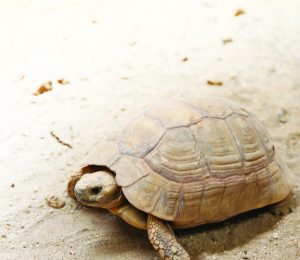Common Grounds
The Greek tortoise is a genetically rich species with a huge variety of subspecies and new subspecies constantly being discovered. Tortoises of different groups often mate, producing offspring with a wide variety of shapes and colors.
“Greek tortoise shell color ranges from yellow to gold and brown to black,” explains Melvin So of Congo Charlie. “There are lots of subspecies being recognized, which causes a lot of confusion for this species, so proper identification is a must.”

Melvin recounts his own experiences with the Greek tortoise. “During the mid 90s, I saw a Greek tortoise in a pet market in Manila, I believe it was smuggled in. But until now, I’ve never heard of people successfully propagating them here in the Philippines.”
As a result, most of the tortoises in the Philippines are wild-caught and packed with parasites, according to Melvin.
The adult Greek tortoise ranges from five to eight inches in length, while hatchlings are less than an inch in length. Melvin says, “We noticed with proper care, they can grow rapidly to four to five inches in two years. There are reports that they can reach 100 years old in captivity. So with optimum care, they canlive quite long.”
Tough Love
The Greek tortoise is a small species with a nasty attitude when it comes to mating. “The male usually rams against the female’s shell to coax her into breeding, and then after the female submits to the male, the male will bite the female’s legs, neck, or face. If the female is not in proper breeding condition, the female may die from this courtship.”
Not for Newbies
Because of the many challenges that come with raising it, such as parasites and breeding issues, Melvin believes that the Greek tortoise is not a tortoise for beginners. “Proper treatment and care are needed for them,” he explains. “The treatment of parasites is not an easy task. Overdosing medicines may kill your tortoise; lack of dosage can make the parasite immune to the medicine.

But even the most careful keeper can run into difficulties. “We have [undergone] some trial and error in treating these parasites. We have lost some, but we managed to treat the rest with thehelp of our veterinarian. It’s very frustrating, but never give up trying,” Melvin says.
The Shell Game
If you believe you’re up to the challenge of raising a Greek tortoise, Melvin has some tips for the beginning keeper. First, make sure that you get a captive-bred (or CB) tortoise so they won’t be loaded with parasites.
Next, feed them a high-fiber, low-protein diet. Tortoises are generally herbivorous, and their natural diet consists of foods that are low in protein. Because of this, their digestive systems are unable to handle a high amount of protein, which may lead to a buildup of uric acid and ultimately kidney failure.

It is extremely important to keep tortoises hydrated, even those that come from arid places. “A shallow water dish with clean water won’t do any harm,” Melvin says. “Heat and UV are also important for all tortoises, as well as enough space for them to roam around. Just like humans, they need a proper diet and sufficient exercise to stay healthy.”
So, what should we look out for in a healthy tortoise? “Check the appearance of the tortoise and see if there is any visible injury on the tortoise,” says Melvin. “Check the eyes if they are bright not sunkenand teary. You must also check if the tortoise is moving properly and make sure the stool is not loose and watery.”
This appeared in Animal Scene magazine’s October 2018 issue.






